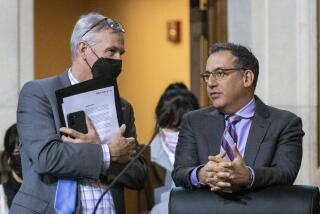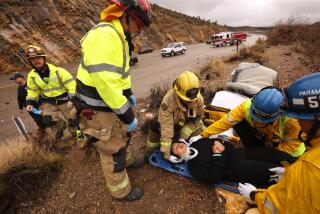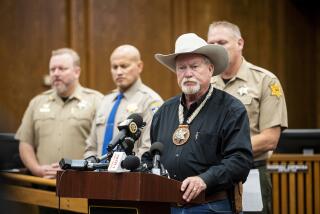Bidding to Determine Who Runs S.D. Emergency Medical Services : Paramedics: City Council vote ends months of wrangling. Fire Department and Hartson Medical Service are expected to bid for the job.
After months of contentious deliberation, the San Diego City Council voted Tuesday to open up the bidding process for managing the cityŌĆÖs paramedic service.
The 7-0 decision puts emergency medical services out for bid, and proposals are expected from the city Fire Department, Hartson Medical Services, the private firm that currently manages paramedics, and other private providers. Councilwoman Abbe Wolfsheimer was absent from the meeting.
The decision came after city officials reviewed a year-long experiment in shared services between the Fire Department and Hartson. The pilot program was adopted as a compromise several months after the issue of turning over the paramedic system to the Fire Department was raised as HartsonŌĆÖs contract was being renewed in 1990.
Under the pilot program, 11 of the cityŌĆÖs 42 fire stations have participated in paramedic service, dispatching a fire engine with a paramedic to medical calls while a Hartson ambulance with two paramedics aboard is also dispatched.
Typically, fire trucks arrive at emergency scenes a few minutes before ambulances, said Ron Saathoff, president of the city fire fighterŌĆÖs union. The Fire Department has argued that response times could be improved if ambulances were operated out of fire stations, Saathoff said.
A publicly operated system would be a dramatic departure from the present one, under which paramedic services are supplied by Hartson, a San Diego-based company. Hartson is under a $2.2-million annual contract that ends in June. It charges patients an average of $353 for each call.
Hartson now uses city-owned ambulances dispatched through a city-owned computer and radio system. One hundred and eight of the cityŌĆÖs paramedics are Hartson employees; 62 are Fire Department paramedics.
Estimates suggest the city could save as much as $2.8 million by dropping the private contractor and operating through the Fire Department, city officials said.
Critics of a city-managed system have disputed the estimates, and raised concerns about start-up costs for a new system, including additional training for some paramedics who will be required to earn certification as firefighters.
The issue has touched off spirited debate in the City Council, and at a hearing on the issue this summer rivalry between council members George Stevens and Tom Behr flared.
The Aug. 11 debate descended into one of the most divisive public feuds to date between two San Diego city officials. Livid over what he felt was disrespectful behavior during the debate over paramedic services, Stevens followed Behr to his office after the meeting adjourned and told him: ŌĆ£IŌĆÖm going to kick your ass.ŌĆØ
Now the voices in council chambers have calmed, but the rifts between both sides of the issue are still deep.
Mayor Maureen OŌĆÖConnor and some members of the City Council have sought public management of the system since a labor dispute at HartsonŌĆÖs in 1990 threatened the companyŌĆÖs contract with the city. The city proposed the transfer of management out of fear of being left without paramedic service, and having to rely on Fire Department personnel with inadequate medical training.
Since October, 1991, residents in the cityŌĆÖs neighborhoods north of Miramar Naval Air Station and in South Bay areas such as Otay Mesa and San Ysidro have been served by the experimental program. The programŌĆÖs primary aim has been to shorten response times.
Deputy City Manager Maureen Stapleton said the shared paramedic arrangement improved response times from 2.4 to 3.9 minutes. However, doctors reviewing cases in the target areas could not determine if patients were directly aided by the quicker response.
There were not enough cardiac arrest cases to establish a correlation between response time and medical benefit, said Jim Dunford, a physician at UC San Diego Medical Center and an adviser to the Fire Department.
Cardiac arrest patients represented fewer than 0.5% of the 5,000 responses studied, said Brad Schwartz, medical adviser to Hartson. Out of 24 patients, a panel of medical reviewers could not find one case where the shared system saved a patient who otherwise would have died, Schwartz said.
Moreover, both Fire Department and HartsonŌĆÖs officials conceded that on-scene service times may have increased. In turn, the overall transport time to hospitals may have increased slightly also, said Thomas W. Morgan, president of the MedTrans, parent company to Hartson.
Fire Department paramedics, who may arrive early but lack equipment to begin treatment, could lengthen the on-scene processing time, Morgan said.
Despite dissatisfaction with the program, the council voted Tuesday to make good on an offer to extend positions to paramedics who voluntarily trained for positions in the pilot program. The number of fire stations in the program was raised to 15. The program was expected to continue until HartsonŌĆÖs contract runs out in June.
When the cityŌĆÖs request for proposals is issued, the Fire Department is expected to submit a plan that calls for a system of 24 ambulances--12 with two paramedics aboard, and another 12 ambulances that will accompany fire engine crews to emergency scenes. In the second grouping, at least one paramedic will be trained as a firefighter in the event that he is needed to respond to a non-medical emergency situation, said the fire fighters unionŌĆÖs Saathoff.
Proposals will be for paramedic service beginning July 1, 1993.
More to Read
Sign up for Essential California
The most important California stories and recommendations in your inbox every morning.
You may occasionally receive promotional content from the Los Angeles Times.










